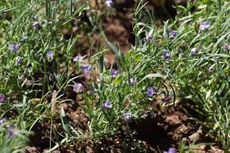Home Garden Barley - How To Grow Barley As A Cover Crop

There are several options for the home gardener when choosing a cover crop, with the goal being to sow a grain or grass that won't reseed itself and can be tilled under to enhance the nutritive value of the soil. Barley (Hordeum vulgare) as a cover crop is an excellent selection.
Winter Barley Cover Crops
Winter barley cover crops are cool season annual cereal grains, which when planted, provide erosion control, weed suppression, add organic matter, and act as a topsoil protectant crop during times of drought.
Other information about winter barley cover crops indicates its low price point and ease of growth, as well as its large area of growth tolerance. Winter barley cover crops prefer cool, dry growing regions and are hardy to USDA growing zone 8 or warmer.
Planted in the spring, home garden barley has a short growth period and, as such, can be planted farther north than other grains. Growing barley also produces a greater biomass in a shorter time frame than other cereals.
How to Grow Barley as a Cover Crop
So, how to grow barley in the home garden? Barley as a cover crop in the home garden is an excellent choice as it is drought tolerant and can be grown in many different soil mediums. Home garden barley thrives in well drained loams and light clay to heavy soil, however, it won't do well in waterlogged areas. Growing barley in salt laden soil also works well, in fact, it is the most tolerant of alkaline soils of any cereal grain.
There are many varieties of barley cover crops, so select one that works in your region. Many types are specifically adapted to high altitudes and a cold, short season of growth.
Prepare a seedbed by raking and hoeing ¾ to 2 inch (2-5 cm.) furrows in the garden. Broadcast whichever barley crop is best suited to your locale, sowing the first half of seeds in one direction then the other half perpendicularly. This method of sowing will give home garden barley the best coverage.
Gardening tips, videos, info and more delivered right to your inbox!
Sign up for the Gardening Know How newsletter today and receive a free download of our DIY eBook "Bring Your Garden Indoors: 13 DIY Projects For Fall And Winter".
For a winter barley cover crop, sow seed from September through February in Zone 8 or warmer. Planting barley cover crops generally works best when seeded before November 1st.
Growing barley does not self reseed very well, which is an advantageous trait for a cover crop. To postpone flowering and, therefore, reduce any chance of reseeding, home garden barley may be mowed.
Why Choose Growing Barley as a Cover Crop?
Growing barley as a cover crop will provide excellent green manure, which improves soil structure, suppresses weed growth, attracts beneficial insects, and increases organic matter. Barley cover crops have deep fibrous roots, sometimes 6 feet (2 m.) deep, which will take up and store excess nitrogen, are heat and drought tolerant, and all at a reasonable cost.
Overwintering with winter barley cover crops is an excellent option for protecting and enhancing garden soils until the spring planting season.

Amy Grant has been gardening for 30 years and writing for 15. A professional chef and caterer, Amy's area of expertise is culinary gardening.
-
 Time For Teal: 7 Terrific Teal Plants To Grow In Your Home Garden
Time For Teal: 7 Terrific Teal Plants To Grow In Your Home GardenIt’s an emerging color with a devoted following in fashion and interiors, but can you enjoy blue-greens in your garden? We round up the best teal plants you can grow
By Tonya Barnett
-
 7 Unique Bonsai Trees You Should Grow For A Stunning, One-Of-A-Kind Display
7 Unique Bonsai Trees You Should Grow For A Stunning, One-Of-A-Kind DisplayDiscover unusual trees you can bonsai, including fruiting and flowering varieties, to create a breathtaking centerpiece in your home or garden.
By Mary Ellen Ellis
-
 Best Late Summer And Early Fall Cover Crops
Best Late Summer And Early Fall Cover CropsPlanting cover crops is a gift you can give to your garden’s soil. Read on to learn about planting cover crops in late summer.
By Bonnie L. Grant
-
 Sunn Hemp Plant Info – Learn Sunn Hemp Uses And Care
Sunn Hemp Plant Info – Learn Sunn Hemp Uses And CareSunn hemp grass is a warm weather grass. Click to learn more about Sunn hemp uses as well as helpful tips on growing Sunn hemp as a cover crop.
By Mary H. Dyer
-
 Native Cover Crops: Vegetable Cover Cropping With Native Plants
Native Cover Crops: Vegetable Cover Cropping With Native PlantsAre there any benefits to using native plants as cover crops? Click here to learn more about vegetable cover cropping with native plants.
By Laura Miller
-
 What Is Field Brome – Information About Field Brome Grass
What Is Field Brome – Information About Field Brome GrassField brome grass can be used as a cover crop to control erosion and enrich the soil. For more information, click the following article.
By Laura Miller
-
 What Is Western Wheatgrass – How To Grow Western Wheatgrass
What Is Western Wheatgrass – How To Grow Western WheatgrassWheatgrass is native to North America and graces the Southwest, Great Plains and mountainous regions of the western U.S. It has some erosion control benefits but using western wheatgrass for grazing is the primary purpose. Learn more about it here.
By Bonnie L. Grant
-
 What Is Chickling Vetch – Growing Chickling Vetch For Nitrogen Fixing
What Is Chickling Vetch – Growing Chickling Vetch For Nitrogen FixingWhat is chickling vetch? Also known by various names such as grass pea, white vetch, blue sweet pea, Indian vetch, or Indian pea, chickling vetch is a nutritious legume grown to feed livestock and humans in countries around the world. Learn more about the plant here.
By Mary H. Dyer
-
Establishing Kura Clover: Learn How To Grow Kura Clover Plants
You no doubt have heard about the four-leaf clover, but few gardeners are familiar with kura clover plants. Kura is a forage legume and if you are interested in growing kura as a groundcover or establishing kura clover for some other use, this article will help.
By Teo Spengler
-
 What Are Austrian Winter Peas: A Guide To Growing Austrian Winter Peas
What Are Austrian Winter Peas: A Guide To Growing Austrian Winter PeasWhat are Austrian winter peas? Also known as field peas, Austrian winter peas have been grown around the world for centuries, primarily as a valuable source of nutrition for humans and livestock. Click this article for info on growing Austrian winter peas.
By Mary H. Dyer